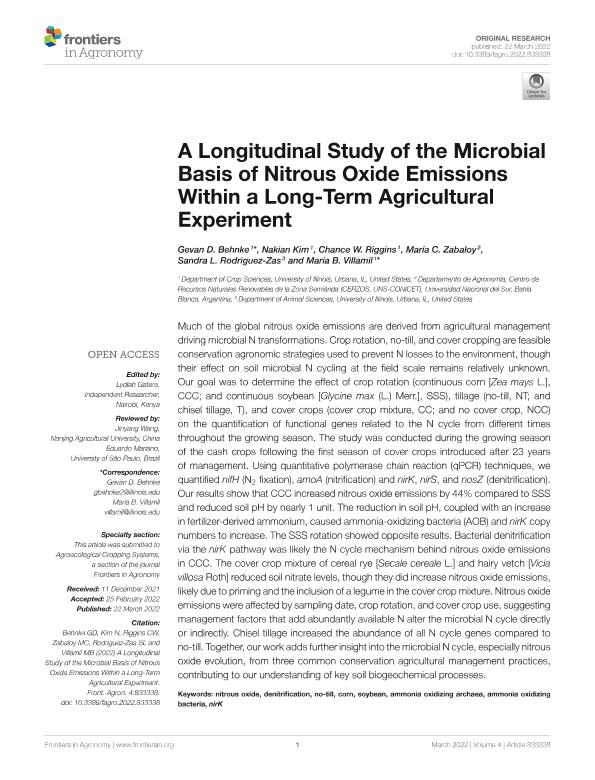Mostrar el registro sencillo del ítem
dc.contributor.author
Behnke, Gevan D.
dc.contributor.author
Kim, Nakian
dc.contributor.author
Riggins, Chance W.
dc.contributor.author
Zabaloy, Maria Celina

dc.contributor.author
Rodriguez Zas, Sandra L.
dc.contributor.author
Villamil, Maria Bonita

dc.date.available
2022-11-01T13:08:58Z
dc.date.issued
2022-03-22
dc.identifier.citation
Behnke, Gevan D.; Kim, Nakian; Riggins, Chance W.; Zabaloy, Maria Celina; Rodriguez Zas, Sandra L.; et al.; A Longitudinal Study of the Microbial Basis of Nitrous Oxide Emissions Within a Long-Term Agricultural Experiment; Frontiers Media; Frontiers in Agronomy; 4; 22-3-2022; 1-17
dc.identifier.uri
http://hdl.handle.net/11336/175806
dc.description.abstract
Much of the global nitrous oxide emissions are derived from agricultural management driving microbial N transformations. Crop rotation, no-till, and cover cropping are feasible conservation agronomic strategies used to prevent N losses to the environment, though their effect on soil microbial N cycling at the field scale remains relatively unknown. Our goal was to determine the effect of crop rotation (continuous corn [Zea mays L.], CCC; and continuous soybean [Glycine max (L.) Merr.], SSS), tillage (no-till, NT; and chisel tillage, T), and cover crops (cover crop mixture, CC; and no cover crop, NCC) on the quantification of functional genes related to the N cycle from different times throughout the growing season. The study was conducted during the growing season of the cash crops following the first season of cover crops introduced after 23 years of management. Using quantitative polymerase chain reaction (qPCR) techniques, we quantified nifH (N2 fixation), amoA (nitrification) and nirK, nirS, and nosZ (denitrification). Our results show that CCC increased nitrous oxide emissions by 44% compared to SSS and reduced soil pH by nearly 1 unit. The reduction in soil pH, coupled with an increase in fertilizer-derived ammonium, caused ammonia-oxidizing bacteria (AOB) and nirK copy numbers to increase. The SSS rotation showed opposite results. Bacterial denitrification via the nirK pathway was likely the N cycle mechanism behind nitrous oxide emissions in CCC. The cover crop mixture of cereal rye [Secale cereale L.] and hairy vetch [Vicia villosa Roth] reduced soil nitrate levels, though they did increase nitrous oxide emissions, likely due to priming and the inclusion of a legume in the cover crop mixture. Nitrous oxide emissions were affected by sampling date, crop rotation, and cover crop use, suggesting management factors that add abundantly available N alter the microbial N cycle directly or indirectly. Chisel tillage increased the abundance of all N cycle genes compared to no-till. Together, our work adds further insight into the microbial N cycle, especially nitrous oxide evolution, from three common conservation agricultural management practices, contributing to our understanding of key soil biogeochemical processes.
dc.format
application/pdf
dc.language.iso
eng
dc.publisher
Frontiers Media

dc.rights
info:eu-repo/semantics/openAccess
dc.rights.uri
https://creativecommons.org/licenses/by/2.5/ar/
dc.subject
NITROUS OXIDE
dc.subject
DENITRIFICATION
dc.subject
NO TILL
dc.subject
CORN
dc.subject
SOYBEAN
dc.subject
AMMONIA OXIDIZING ARCHAEA
dc.subject
AMMONIA OXIDIZING BACTERIA
dc.subject
NIR K
dc.subject.classification
Biología Celular, Microbiología

dc.subject.classification
Ciencias Biológicas

dc.subject.classification
CIENCIAS NATURALES Y EXACTAS

dc.subject.classification
Ciencias del Suelo

dc.subject.classification
Agricultura, Silvicultura y Pesca

dc.subject.classification
CIENCIAS AGRÍCOLAS

dc.title
A Longitudinal Study of the Microbial Basis of Nitrous Oxide Emissions Within a Long-Term Agricultural Experiment
dc.type
info:eu-repo/semantics/article
dc.type
info:ar-repo/semantics/artículo
dc.type
info:eu-repo/semantics/publishedVersion
dc.date.updated
2022-07-04T19:18:23Z
dc.identifier.eissn
2673-3218
dc.journal.volume
4
dc.journal.pagination
1-17
dc.journal.pais
Suiza

dc.description.fil
Fil: Behnke, Gevan D.. University of Illinois at Urbana; Estados Unidos
dc.description.fil
Fil: Kim, Nakian. University of Illinois at Urbana; Estados Unidos
dc.description.fil
Fil: Riggins, Chance W.. University of Illinois at Urbana; Estados Unidos
dc.description.fil
Fil: Zabaloy, Maria Celina. Consejo Nacional de Investigaciones Científicas y Técnicas. Centro Científico Tecnológico Conicet - Bahía Blanca. Centro de Recursos Naturales Renovables de la Zona Semiárida. Universidad Nacional del Sur. Centro de Recursos Naturales Renovables de la Zona Semiárida; Argentina. Universidad Nacional del Sur. Departamento de Agronomía; Argentina
dc.description.fil
Fil: Rodriguez Zas, Sandra L.. University of Illinois at Urbana; Estados Unidos
dc.description.fil
Fil: Villamil, Maria Bonita. Consejo Nacional de Investigaciones Científicas y Técnicas; Argentina. University of Illinois at Urbana; Estados Unidos
dc.journal.title
Frontiers in Agronomy
dc.relation.alternativeid
info:eu-repo/semantics/altIdentifier/url/https://www.frontiersin.org/articles/10.3389/fagro.2022.833338/full
dc.relation.alternativeid
info:eu-repo/semantics/altIdentifier/doi/http://dx.doi.org/10.3389/fagro.2022.833338
Archivos asociados
